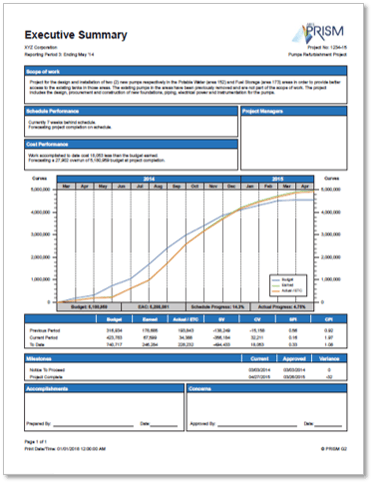Proper project reporting is a complex task that requires understanding how the project fits into the overall portfolio of your organization and how it impacts your customer(s). It’s important to tailor your reporting to what your stakeholders want to see. Tailoring each report to its audience reduces the workload on your project staff. When reports are well aimed, stakeholders are seeing the data they need with minimal excess.
The first step in designing any project reports should be querying the audience. With that said, there are some common needs among various stakeholder groups that may give you a good starting point.
Clients and Customers
External reporting can be tricky and your customer may have specific reporting requirements in the contract. For most customers, a monthly executive summary containing overall project status, s-curve, and major milestone list with planned, forecast, and estimated dates are appropriate. If the project is trending into variance, it will be important to include variance specific reports with explanations as well as planned and taken actions to correct the variance.
Directors
A board of directors is usually not interested in low-level details of how a project is progressing and performing. This may not hold true for projects missing their targets, but in those cases, you should tailor reports to focus on the status of project issues. Generally, directors will want an executive summary of each project like what you’re giving your customers and a single report containing key indices for every project in the company’s portfolio.
Vice Presidents
VPs generally like to see reports that show how each group they oversee is performing, regardless of the project. This can be difficult if every project’s control accounts are not split and coded at the enterprise level to allow for that kind of data grouping. Keep this reporting need in mind when designing and defining enterprise and project data structures.
Program Management Office
A PMO will want to see reports like those for directors that show how every program and project in the company portfolio is doing. They may also be interested in the level of effort, project overhead type of work like the PMO itself. Actual costs should be compared to what was budgeted to ensure project budgeting and cost allocation methods are still sound.
Project Managers
Project managers are possibly the most difficult group to tailor reports to. They want the same summary level information you might give a director until they start seeing variances. Then they want every detail you can dig up so they can find the source of the issue. Different managers want different details in monthly reports and most will want an analysis of any variance over a certain threshold. It’s best to work closely with PMs to develop a standard set of reports and then branch out from there as needed.
Line Supervisors and Hiring Managers
Supervisors for line staff generally aren’t interested in how the overall project is doing. They have a focus on the parts of the project that depends on their staff. Similarly, dollars mean very little to a line supervisor. They tend to think in hours as it helps them quickly see and plan for staffing needs.
Managers and supervisors with a budget to manage will appreciate reports on rates. Showing budgeted vs actual labor rates can help to quickly identify which work might be in danger of blowing the budget due to labor cost trends.
Conclusion
ARES PRISM, specifically its Cost Management package, has the tools to create the reports and perform the analysis discussed above. The package contains built-in versions of executive summary reports, variance explanation, unit cost (labor rate), progress, performance index, and s-curve reports plus many more. Reporting is flexible in how you summarize, group, and display your data, allowing you the customization necessary to tailor reports to stakeholder needs. ARES PRISM is also a great tool for deeper variance analysis. With your cost, schedule, scope, and budget information all in one place, it’s a much simpler task to see the source of the issue.
Continuous improvement applies to reporting as well as it does anything else in project management. It is important to realize that reporting is not a “set it and forget it” kind of thing. That sort of behavior contributes to complacency and can lead to a project that is allowed to trend off target. Initial designs for reports serve as a starting point for conversations around how to improve those reports to stakeholder needs. Consistency is important too, so don’t go changing reports on your own whims. Simply ensure that the usefulness of reports is a constant conversation. Employ good change management techniques as your reports evolve into the tools your stakeholders truly need.
